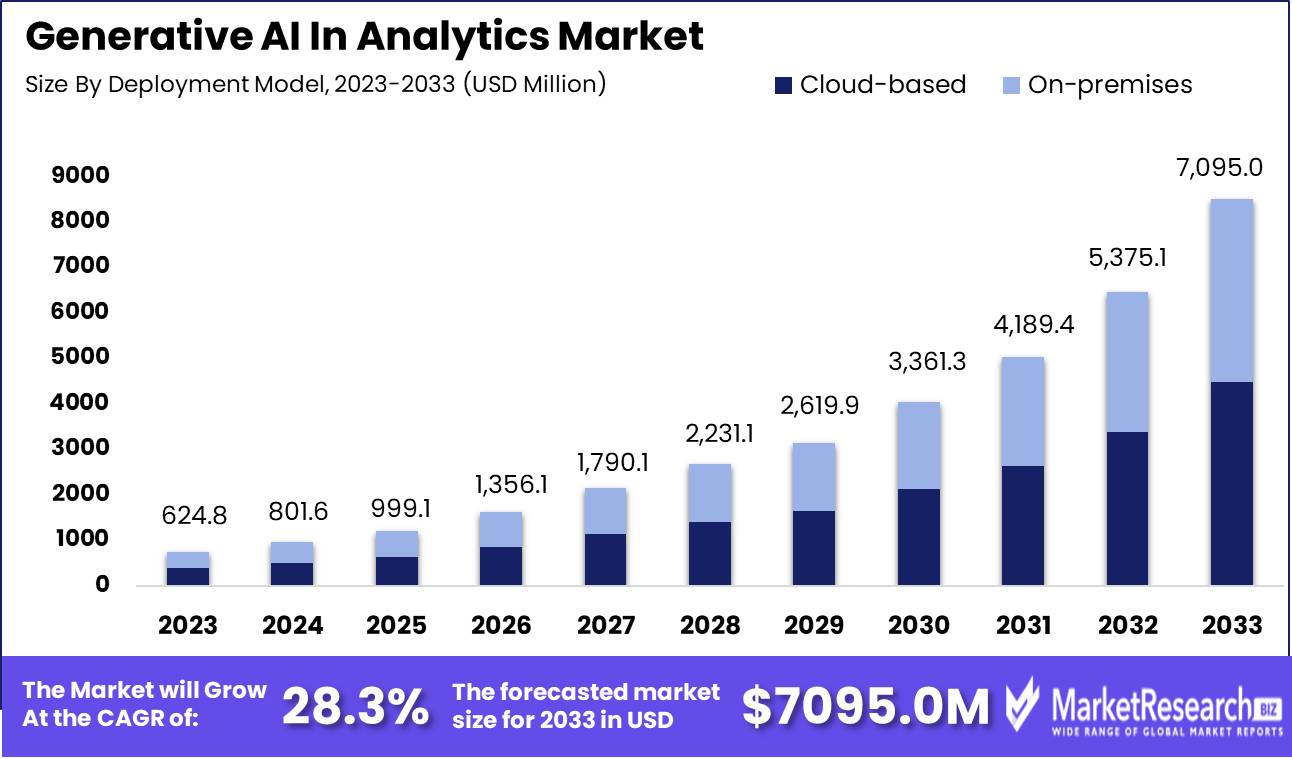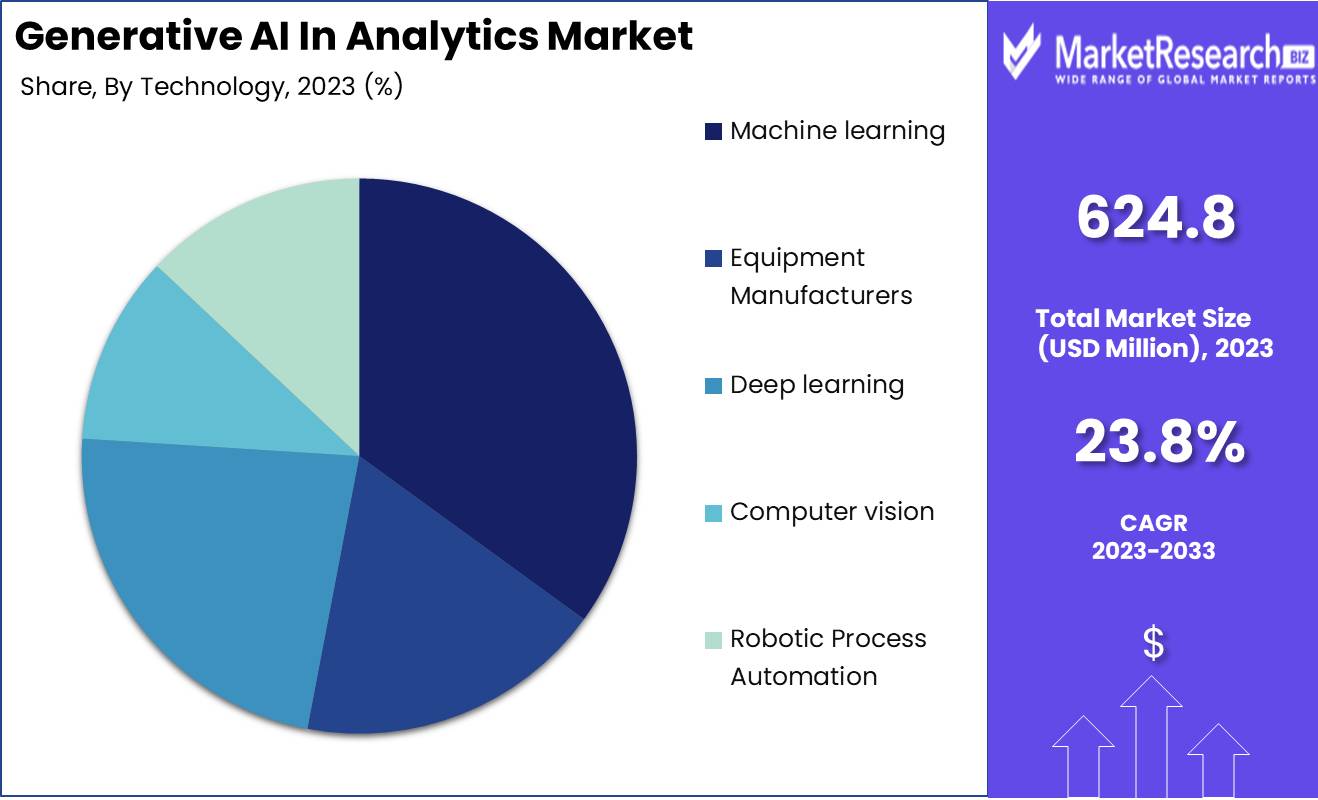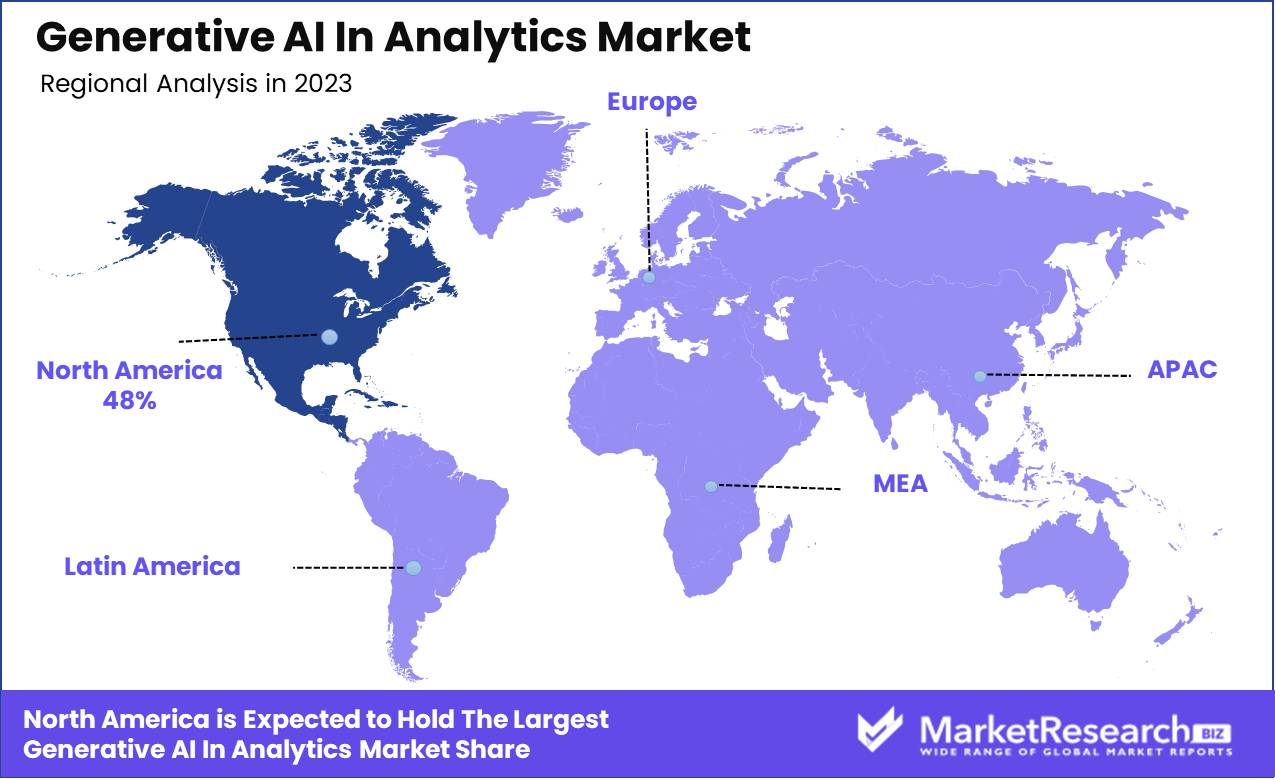
Global Generative AI in Analytics Market by Deployment Mode (Cloud-based and On-premises), By Technology (Machine learning, Natural Language Processing and others), By Application (Data Augmentation, Anomaly Detection, and Other ) By Region and Companies - Industry Segment Outlook, Market Assessment, Competition Scenario, Trends, and Forecast 2024-2033
-
37130
-
April 2024
-
300
-
-
This report was compiled by Vishwa Gaul Vishwa is an experienced market research and consulting professional with over 8 years of expertise in the ICT industry, contributing to over 700 reports across telecommunications, software, hardware, and digital solutions. Correspondence Team Lead- ICT Linkedin | Detailed Market research Methodology Our methodology involves a mix of primary research, including interviews with leading mental health experts, and secondary research from reputable medical journals and databases. View Detailed Methodology Page
-
Quick Navigation
Report Overview
The Generative AI in Analytics Market size is expected to be worth around USD 7,095.0 Mn by 2033 from USD 624.8 Mn in 2023, growing at a CAGR of 28.3% during the forecast period from 2024 to 2033.
The surge in demand for predictive analysis and new advanced technologies are some of the main key driving factors for generative artificial intelligence in the analytics market. Analytics is all about data analysis. The world of data analytics is like a complex puzzle that is filled with lots of information and technical processes. Old data analytics procedures needed a lot of time to process and analyze data but sometimes this procedure leaves precious insights that are left unused.
Generative AI in analytics is changing the way of understanding, analyzing, and using data by making it simpler and more natural. It helps the developers to work efficiently and generate good-quality productivity. A report published by GitHub in September 2023, highlights that between 60% to 70% of developers who are using GitHub, a Generative AI tool help them to fulfill their job and also in developing codes. These developers can focus more when they are using GitHub Copilot. Additionally, GitHub Copilot which is powered by the Generative AI tool helps 73% of the developers to stay in flow as well and this technology also helped 87% of developers to conserve their mental energy while performing any monotonous tasks.

GenAI provides proactive recommendations with capable insights and reveals hidden patterns. Generative analytics is all about making data analysis more unique and original, less about changing through spreadsheets, and more about producing meaningful and understandable insights.
The capability of generative AI in analytics is immense. Old BI tools were used to be geared toward data professionals, but GenAI opens new opportunities for data analytics to those individuals who do not have any background or skills in data science. This technology is created to be unique by making data analysis much easier to access to a wide range of users starting from marketing experts to small business entrepreneurs. GenAI permits different types of user personalities to engage with and benefit from data without the sheer learning pattern which is basically related to old BI tools.
There are several advantages of using GenAI in analytics such as it helps to identify fraud detection, create effective customer segmentation, and helps in predictions of future demand based on past sales data or any other related factors. This technology also helps in credit scoring for example, a credit scoring firm uses GenAI to produce synthetic data that is similar to various types of debtors, which is used to train ML models to forecast credit risk better. The demand for generative AI in the analytics market will increase rapidly due to high requirements in different verticals of the market that will help in market expansion during the forecasted period.
Key Takeaways
- Market Growth: The Generative AI in Analytics Market size is expected to be worth around USD 7,095.0 Mn by 2033 from USD 624.8 Mn in 2023, growing at a CAGR of 28.3% during the forecast period from 2024 to 2033.
- By Deployment Mode: In 2023, cloud-based solutions led the Generative AI Analytics Market with a 58% share, driven by scalability and cost-efficiency.
- By Technology: In 2023, Machine Learning led the Generative AI Analytics Market with a 29% share.
- By Application: In 2023, Data Augmentation dominated, capturing over 33% market share, meeting the demand for improved ML accuracy.
- Regional Dominance: North America leads the Generative AI Analytics Market, setting global benchmarks with a 48% share.
- Growth Opportunity: Generative AI integrated with BI optimizes data-driven decision-making and scenario planning, enhancing business performance.
Driving factors
Technological Advancements Propel Market Evolution
The continuous progression in computational power and algorithmic efficiency has dramatically enhanced the capabilities of generative AI. Innovations such as GPT (Generative Pre-trained Transformer) and similar models have revolutionized how data is analyzed and interpreted, enabling more sophisticated, predictive, and generative analytics solutions. These advancements not only improve the speed and accuracy of data processing but also expand the potential use cases of AI in analytics, thereby driving market growth.
For instance, advancements in AI models have facilitated the development of tools capable of synthesizing and interpreting large datasets at unprecedented speeds and accuracy. This capability is critical in domains such as real-time analytics and big data environments, where the volume and velocity of data exceed the processing capabilities of traditional analytical tools.
Global Adoption Across Diverse Industries Enhances Market Penetration
Generative AI's versatility is showcased in its widespread adoption across various sectors, including content writing, media and entertainment, and IT & telecommunications. Each of these industries has unique demands and use cases for AI, contributing collectively to the market's expansion.
In content writing, generative AI tools help automate content creation, enhancing productivity and allowing human writers to focus on more complex editorial tasks.
In media and entertainment, these tools are used for everything from scriptwriting to creating digital content, thereby transforming traditional production processes and content personalization.
IT and telecommunications use generative AI to manage data traffic, predict system failures, and optimize network operations, reducing costs and improving service reliability.
The adoption in these fields not only broadens the market for generative AI in analytics but also serves as a testament to its robustness and adaptability, encouraging further integration into other sectors.
Increasing Utilization by Businesses Drives Operational Efficiencies
Businesses across the spectrum are increasingly integrating generative AI into their operations to enhance decision-making and operational efficiency. This widespread adoption can be attributed to AI's ability to generate insights from data that are not readily apparent through traditional analysis methods. For example, generative AI can predict market trends, consumer behavior, and potential operational bottlenecks, enabling businesses to make proactive adjustments.
The economic impact of AI-driven analytics is significant. Businesses that adopt AI technologies can see a reduction in operational costs, improved customer satisfaction through personalized services, and an overall increase in revenue due to more targeted and effective strategies. As more businesses realize the potential ROI from integrating AI into their analytics, the market for generative AI is expected to grow, fueled by both the demand for advanced analytical capabilities and the competitive necessity to leverage these technologies.
Restraining Factors
Data Privacy and Security Concerns: A Primary Barrier to Adoption
Data privacy and security remain paramount concerns within the generative AI in the analytics market. As organizations increasingly rely on AI to interpret and generate insights from vast datasets, the potential for data breaches and misuse escalates. Regulations such as GDPR in Europe and CCPA in the United States impose stringent compliance requirements on data handling, impacting how companies can deploy AI solutions.
These legal frameworks necessitate robust security measures and transparent data management practices, thereby increasing the operational costs and complexity for businesses adopting generative AI technologies. This factor significantly restrains market growth as potential adopters may hesitate or delay implementation due to fears of regulatory penalties and reputational damage.
Integration with Legacy Systems: Slowing Down Implementation Speed
Integrating generative AI into existing legacy systems presents substantial challenges that can impede market growth. Many organizations operate on outdated technological infrastructures that are not readily compatible with the advanced computational requirements of generative AI. This discordance necessitates extensive system upgrades or even complete overhauls, entailing significant investment in time and resources.
The slow and costly process of integration can deter companies, especially small to medium-sized enterprises with limited IT budgets, from adopting generative AI solutions. Consequently, the difficulty in meshing new AI technologies with old systems can significantly slow down market expansion, limiting the reach and scalability of generative AI applications within the analytics domain.
By Deployment Mode Analysis
In 2023, cloud-based solutions led the Generative AI Analytics Market with a 58% share, driven by scalability and cost-efficiency.
In 2023, Cloud-based solutions held a dominant market position in the Based on Deployment Mode segment of the Generative AI in Analytics Market, capturing more than 58% of the market share. This significant adoption is driven by the scalability, flexibility, and cost-efficiency that cloud-based platforms offer. Businesses, especially those in dynamic sectors such as retail and finance, are leveraging cloud-based generative AI to enhance real-time decision-making and data-driven strategies. The cloud deployment model enables companies to deploy AI solutions rapidly and at scale, reducing the need for substantial upfront capital investments and ongoing maintenance that on-premises solutions typically require.
On the other hand, the On-premises segment continues to appeal to industries with stringent data security requirements, such as healthcare and government. While it represents a smaller portion of the market, this segment benefits from having direct control over the data environment, which is crucial for compliance with strict regulatory standards. The on-premises model offers enhanced security and data privacy, providing organizations the confidence to leverage generative AI capabilities while managing sensitive information in-house. Despite its smaller market share, the demand for on-premises solutions is anticipated to grow as advancements in AI increase its accessibility and as organizations continue to prioritize data sovereignty.
By Technology Analysis
In 2023, Machine Learning led the Generative AI Analytics Market with a 29% share.
In 2023, Machine Learning held a dominant market position in the "Based on Technology" segment of the Generative AI in Analytics Market, capturing more than a 29% share. This robust performance is indicative of Machine Learning's foundational role in driving sophisticated analytical tools and applications across various industries. The prominence of Machine Learning is largely due to its versatility in handling vast datasets and its capability to improve over time through continuous learning, making it indispensable for predictive analytics, customer behavior forecasting, and operational optimization.
Following closely are technologies like Natural Language Processing (NLP) and Deep Learning, which are also critical to the expansion of generative AI capabilities within the analytics domain. NLP, integral for processing and analyzing human language data, has enhanced the way businesses understand consumer sentiments and intent at scale. Meanwhile, Deep Learning excels in interpreting complex data patterns, thereby enhancing decision-making processes and creating more accurate forecasting models. These technologies complement Machine Learning, providing a multi-layered approach to analytical challenges.
The other significant segments within this market include Computer Vision and Robotic Process Automation (RPA). Computer Vision has been pivotal in industries where visual data plays a key role, such as retail and healthcare, by enabling more efficient and automated operations. On the other hand, RPA has been transformative in automating routine tasks, allowing businesses to reallocate resources to more strategic activities, thus optimizing overall productivity. The integration of these technologies underlines a comprehensive ecosystem in the Generative AI and Analytics landscape, promising enhanced efficiency and more informed decision-making across sectors.

By Application Analysis
In 2023, Data Augmentation dominated, capturing over 33% market share, meeting the demand for improved ML accuracy.
In 2023, Data Augmentation held a dominant market position in the Based on Application segment of the Generative AI in the Analytics Market, capturing more than a 33% share. This substantial market presence can be attributed to the increasing demand across various industries for enhanced data quality and quantity, which is crucial for improving the accuracy of machine learning models.
Data augmentation techniques have proven essential in sectors such as healthcare, automotive, and retail, where they help create robust models by generating synthetic data that simulate real-world variability. These techniques not only enhance the breadth and depth of data sets but also ensure better model generalization, thus driving significant adoption.
Anomaly Detection follows as another significant application of Generative AI in analytics. Industries such as finance, cybersecurity, and manufacturing leverage anomaly detection to identify unusual patterns that may indicate fraud, security breaches, or system failures. The application of Generative AI here allows for more sophisticated and nuanced detection mechanisms compared to traditional statistical methods. By 2023, companies have increasingly integrated Generative AI into their operational technology to proactively manage risks, leading to heightened efficiency and security measures.
Text Generation and Simulation and Forecasting are other critical areas where Generative AI is making a marked impact. In media, entertainment, and customer service, Generative AI-driven text generation powerful tools have revolutionized content creation, providing scalable solutions for generating written content that can mimic human tone and complexity.
Key Market Segments
Based on the Deployment Mode
- Cloud-based
- On-premises
Based on Technology
- Machine learning
- Natural Language Processing
- Deep learning
- Computer vision
- Robotic Process Automation
Based on Application
- Data Augmentation
- Anomaly Detection
- Text Generation
- Simulation and Forecasting:
- Other Applications
Growth Opportunity
Integration with Business Intelligence (BI): Maximizing Data Synergy
The integration of Generative AI with Business Intelligence (BI) systems heralds a new era of data-driven decision-making. By amalgamating the power of AI-generated insights with BI platforms, organizations can delve deeper into their data reservoirs, extracting actionable intelligence at unprecedented speeds. This integration streamlines the analytics process, offering real-time insights that empower businesses to make agile, informed decisions. From predictive analytics to trend analysis, the synergy between Generative AI and BI amplifies analytical capabilities, paving the way for enhanced operational efficiency and strategic foresight.
Scenario Planning and Simulations: Navigating Uncertainty with Precision
In an era marked by volatility and uncertainty, scenario planning and simulations emerge as indispensable tools for strategic planning. Generative AI, with its ability to simulate myriad scenarios based on historical data and real-time inputs, equips businesses with the foresight to navigate complex landscapes with confidence. Whether anticipating market fluctuations, optimizing supply chain logistics, or mitigating risks, Generative AI-driven simulations offer a holistic view of potential outcomes, empowering organizations to proactively devise resilient strategies. By harnessing the predictive prowess of Generative AI, businesses can fortify their competitive edge and thrive amidst uncertainty.
Research indicates that businesses that employ scenario planning techniques are 2.2 times more likely to experience above-average profitability compared to those that do not. This underscores the importance of leveraging generative AI for scenario planning and simulations in enhancing business performance and resilience.
Latest Trends
Advancements in Generative Creative AI
The global Generative AI in Analytics Market is witnessing a significant surge driven by remarkable advancements in Generative Creative AI. This trend marks a paradigm shift in how businesses leverage AI to generate innovative solutions, designs, and content. Generative Creative AI systems, empowered by deep learning and neural networks, are now capable of producing high-quality outputs in diverse domains, including art, design, and music.
These systems not only mimic human creativity but also enhance it by offering novel perspectives and generating ideas that may not have been conceived otherwise. Companies across various industries are increasingly incorporating Generative Creative AI into their workflows to streamline creative processes, enhance product development, and deliver personalized experiences to customers.
AI-Powered Natural Language Generation
Another prominent trend shaping the landscape of the global Generative AI in the Analytics Market is the proliferation of AI-powered Natural Language Generation (NLG) technologies. NLG systems leverage advanced algorithms to transform structured data into human-like narratives, reports, and insights. With the exponential growth of data in the digital age, there is a growing demand for automated tools that can extract actionable insights from large datasets and communicate them coherently and understandably.
AI-powered NLG solutions address this need by enabling organizations to generate dynamic reports, summaries, and explanations in real time, thereby enhancing decision-making processes and driving operational efficiency. As the adoption of NLG continues to expand across industries such as finance, healthcare, and marketing, it is poised to play a pivotal role in shaping the future of analytics and business intelligence.
Regional Analysis
North America leads the Generative AI Analytics Market, setting global benchmarks with a 48% share.
North America dominates the Generative AI in the Analytics market, accounting for a significant share of 48%. This dominance is attributed to the presence of major market players, technological advancements, and robust infrastructure supporting AI development. The region boasts a mature market ecosystem with high adoption rates of AI technologies across various industries such as healthcare, finance, and retail.

Europe holds a substantial share in the Generative AI Analytics market, driven by the presence of a large number of enterprises embracing AI solutions for data analysis and decision-making processes. The European Union's focus on fostering innovation and digital transformation across sectors contributes to the growth of the AI market in the region. Countries like the UK, Germany, and France are among the key contributors to the market growth, supported by a well-established IT infrastructure and a skilled workforce.
The Asia Pacific region exhibits immense potential for growth in the Generative AI in Analytics market, fueled by rapid technological advancements, increasing digitalization, and the adoption of AI-driven solutions across industries. Countries such as China, India, and Japan are at the forefront of AI innovation, with burgeoning investments in AI research and development. The presence of a large population and a rising demand for advanced analytics solutions further augments market expansion in the region.
The Middle East & Africa region is witnessing steady growth in the Generative AI in Analytics market, driven by the adoption of AI technologies in sectors like oil & gas, healthcare, and manufacturing. Governments in the region are investing in AI infrastructure to enhance operational efficiency and foster economic diversification. Despite facing challenges such as limited technical expertise and infrastructure development, the region presents lucrative opportunities for market players due to increasing digitization efforts and a growing awareness of AI benefits.
Latin America is emerging as a promising market for Generative AI in Analytics, supported by the growing adoption of AI technologies in sectors like telecommunications, banking, and e-commerce. Countries like Brazil, Mexico, and Argentina are witnessing significant investments in AI-driven analytics solutions to improve business outcomes and gain a competitive edge.
Key Regions and Countries
North America
- The US
- Canada
- Rest of North America
Europe
- Germany
- France
- The UK
- Spain
- Netherlands
- Russia
- Italy
- Rest of Europe
Asia-Pacific
- China
- Japan
- Singapore
- Thailand
- South Korea
- Vietnam
- India
- New Zealand
- Rest of Asia Pacific
Latin America
- Mexico
- Brazil
- Rest of Latin America
Middle East & Africa
- Saudi Arabia
- South Africa
- UAE
- Rest of the Middle East & Africa
Key Players Analysis
In the ever-evolving landscape of artificial intelligence, several key players have emerged as frontrunners, shaping the trajectory of the global Generative AI in Analytics Market in 2024. OpenAI, a leader renowned for its cutting-edge research and development in AI, stands at the forefront. With its advanced language models and commitment to open research, OpenAI continues to push the boundaries of generative AI, offering innovative solutions that redefine analytics capabilities.
Google, with its vast resources and expertise in machine learning, remains a dominant force in the market. Leveraging its extensive data infrastructure and AI-driven products, Google pioneers advancements in generative AI applications for analytics, driving efficiency and insight generation for businesses worldwide. NVIDIA, renowned for its high-performance computing solutions, plays a pivotal role in accelerating AI innovation. Its GPUs power a myriad of generative AI applications, enabling real-time data processing and complex model training for enhanced analytics capabilities.
Microsoft, Adobe, IBM, Oracle, SAP SE, and Workday Inc. each contribute significantly to the global Generative AI in the Analytics Market. With their diverse portfolios spanning cloud services, data analytics platforms, and enterprise solutions, these companies offer comprehensive AI-driven analytics solutions tailored to various industries and business needs. Moreover, ADP and other key players contribute niche expertise and specialized offerings, further enriching the ecosystem with unique insights and capabilities.
Market Key Players
- OpenAI
- NVIDIA
- Microsoft
- Adobe
- IBM
- Oracle
- SAP SE
- Workday Inc
- ADP
- Other Key Players
Recent Development
- In March 2024, FN Media Group LLC reported that the global artificial intelligence market is experiencing significant growth, driven by advances in technologies like big data analytics, robotics, and IoT, with a projection to reach $1,345.2 billion by 2030. The report also highlights the strategic partnership between the Kingdom of Saudi Arabia and Resolve AI to establish an AI Centre of Excellence as part of Saudi Arabia's Vision 2030 innovation goals.
- In February 2024, C3.ai, Inc., a leading enterprise AI software provider based in Redwood City, California, announced its fiscal Q3 financial results, showing a robust 18% year-over-year revenue increase to $78.4 million, alongside significant advancements in customer engagements and strategic partnerships.
- In January 2024, EY India, reported forecasts for a surge in retail investments in AI, predicting it will increase from US$5 billion to US$31 billion by 2028. The report also estimates that Gen AI could boost retail sector profitability by 20% by 2025, despite 80% of organizations reporting low-to-moderate readiness for AI adoption.
Report Scope
Report Features Description Market Value (2023) USD 624.8 Million Forecast Revenue (2033) USD 7,095.0 Million CAGR (2024-2032) 28.30% Base Year for Estimation 2023 Historic Period 2016-2023 Forecast Period 2024-2033 Report Coverage Revenue Forecast, Market Dynamics, COVID-19 Impact, Competitive Landscape, Recent Developments Segments Covered By Deployment Mode (Cloud-based and On-premises), By Technology (Machine learning, Natural Language Processing, Deep learning, Computer vision, and Robotic Process Automation), By Application (Data Augmentation, Anomaly Detection, Text Generation, Simulation and Forecasting, and Other Applications) Regional Analysis North America - The US, Canada, Rest of North America, Europe - Germany, France, The UK, Spain, Italy, Russia, Netherlands, Rest of Europe, Asia-Pacific - China, Japan, South Korea, India, New Zealand, Singapore, Thailand, Vietnam, Rest of Asia Pacific, Latin America - Brazil, Mexico, Rest of Latin America, Middle East & Africa - South Africa, Saudi Arabia, UAE, Rest of Middle East & Africa Competitive Landscape OpenAI, Google, NVIDIA, Microsoft, Adobe, IBM, Oracle, SAP SE, Workday Inc, ADP, and Other Key Players Customization Scope Customization for segments, region/country-level will be provided. Moreover, additional customization can be done based on the requirements. Purchase Options We have three licenses to opt for Single User License, Multi-User License (Up to 5 Users), Corporate Use License (Unlimited User and Printable PDF) Related Market Research Reports
-
-
- OpenAI
- NVIDIA
- Microsoft
- Adobe
- IBM
- Oracle
- SAP SE
- Workday Inc
- ADP
- Other Key Players




